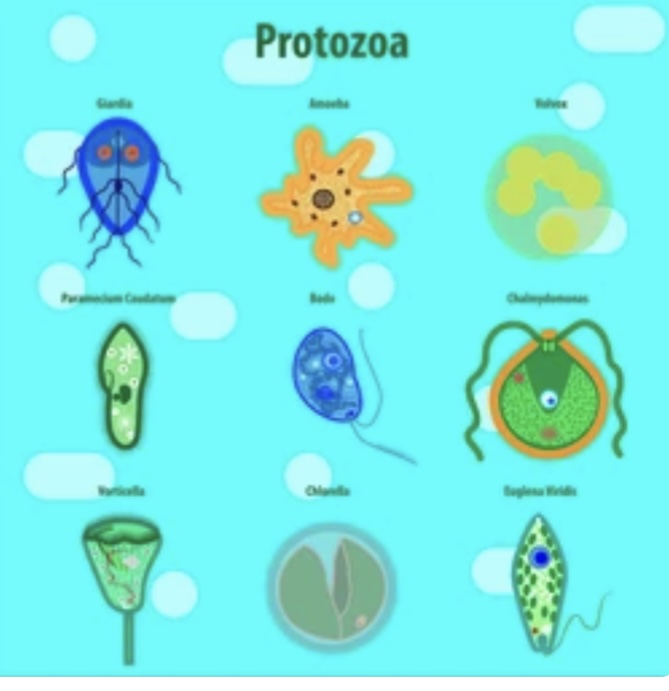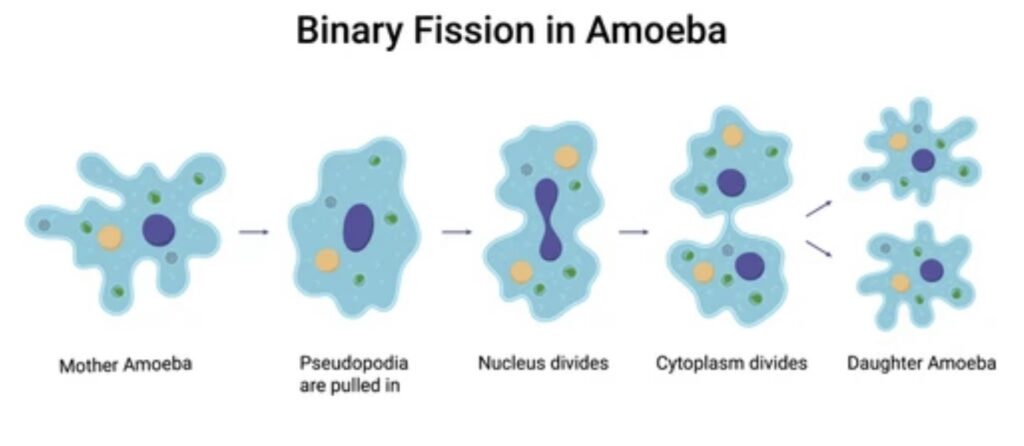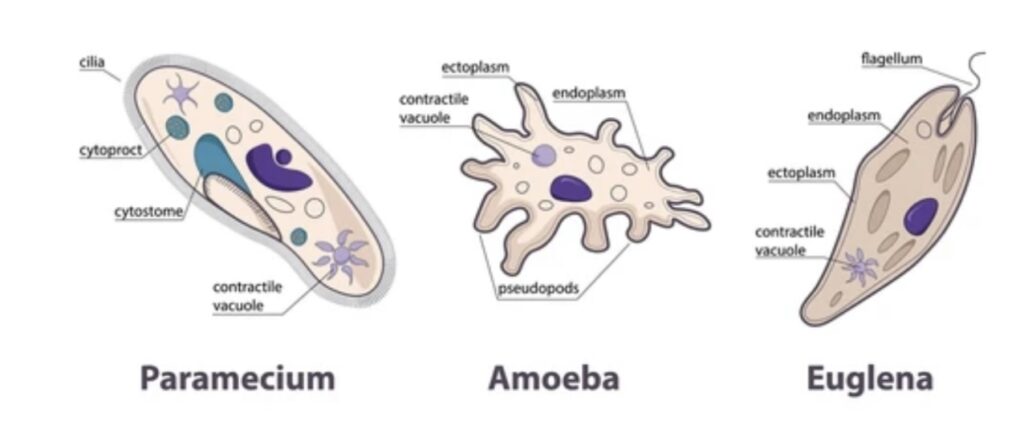INTRODUCTION

Phylum Protozoa includes a diverse group of single-celled eukaryotic organisms that belong to the kingdom Protista. They exhibit a remarkable range of characteristics and inhabit a wide variety of environments, including freshwater, marine habitats, soil, and even the bodies of other organisms. In this article, we will explore the key features, classification, reproduction, ecological significance, and some examples of protozoa.
CHARACTERISTICS OF PROTOZOA
- Unicellular Nature: Protozoa are single-celled organisms, meaning they are composed of a single cell that performs all necessary functions of life. Despite their unicellular nature, protozoa can exhibit complex structures and behavior.
- Eukaryotic Cells: Protozoa are eukaryotes, which means they possess a true nucleus and other membrane-bound organelles within their cells. These organelles enable various cellular processes, such as energy production, protein synthesis, and cell division.
- Diverse Forms: Protozoa display a wide variety of forms, ranging from amoeboid, ciliate, flagellated, to spore-forming. Each form is adapted to specific modes of movement, feeding, and reproduction.
- Locomotion: Protozoa exhibit diverse mechanisms of locomotion. Some protozoa move by extending and retracting pseudopodia (false feet), as seen in amoeboid forms like Amoeba. Others use specialized structures such as cilia or flagella for movement.
- Nutrition: Protozoa are heterotrophic organisms, meaning they obtain nutrients by consuming other organisms or organic matter. They exhibit various feeding strategies, including phagocytosis (engulfing solid particles), osmotrophy (absorbing dissolved organic matter), or parasitism (living off a host organism).
- Reproduction: Protozoa can reproduce both asexually and sexually. Asexual reproduction occurs through binary fission, where the cell divides into two identical daughter cells. Some protozoa also reproduce through budding, where a small outgrowth develops into a new individual. Sexual reproduction involves the fusion of gametes from different individuals to form a zygote.

CLASSIFICATION OF PROTOZOA
Protozoa are classified into several phyla based on their structural characteristics, locomotion, and other features. The major phyla of protozoa include:
- Amoebozoa: This phylum includes amoeboid forms such as Amoeba, characterized by their flexible pseudopodia and absence of permanent organelles for locomotion.
- Ciliophora: Ciliates, including Paramecium and Stentor, belong to this phylum. They are covered in numerous hair-like structures called cilia, which facilitate movement and feeding.
- Euglenozoa: Euglenoids, such as Euglena, possess a characteristic whip-like tail called a flagellum that aids in locomotion. They often have chloroplasts and can perform photosynthesis.
- Apicomplexa: This phylum consists of parasitic protozoa, including Plasmodium (the causative agent of malaria) and Toxoplasma. They possess a specialized organelle called an apical complex, which aids in host cell invasion.
- Dinoflagellata: Dinoflagellates are marine or freshwater protozoa with two flagella, giving them a characteristic spinning movement. Some species are photosynthetic, while others are heterotrophic.
ECOLOGICAL SIGNIFICANCE OF PROTOZOA
Protozoa play crucial roles in various ecosystems. They serve as important links in food chains, consuming bacteria, algae, and other microorganisms. In turn, they are preyed upon by larger organisms, contributing to nutrient cycling.
EXAMPLES OF PROTOZOA
Protozoa represent a diverse group of single-celled organisms with a wide range of forms and lifestyles. Here are some examples of protozoa:

- Amoeba (Amoeboid Protozoa): Amoebas, such as Amoeba proteus, are well-known examples of amoeboid protozoa. They possess a flexible body and move by extending pseudopodia (false feet) in various directions. Amoebas are found in freshwater habitats and feed on bacteria and other small organisms.
- Paramecium (Ciliate Protozoa): Paramecium caudatum is a common example of ciliate protozoa. It is covered in numerous hair-like structures called cilia, which aid in movement and feeding. Paramecia are typically found in freshwater environments and feed on bacteria and other small organisms using their cilia.
- Euglena (Flagellate Protozoa): Euglena gracilis is an example of a flagellate protozoan. It possesses a whip-like tail called a flagellum that allows it to move in aquatic environments. Euglenas can be photosynthetic, containing chloroplasts and performing photosynthesis, but they can also feed on organic matter in the absence of light.
- Plasmodium (Apicomplexan Protozoa): Plasmodium is a genus of parasitic protozoa that causes malaria in humans. Various species of Plasmodium, such as Plasmodium falciparum and Plasmodium vivax, are transmitted through the bites of infected mosquitoes. The complex life cycle of Plasmodium involves multiple stages within both mosquito and human hosts.
- Trypanosoma (Flagellate Protozoa): Trypanosoma brucei is a flagellate protozoan responsible for causing African trypanosomiasis, also known as sleeping sickness, in humans. It is transmitted by the bite of infected tsetse flies. Trypanosomes have a distinctive elongated body and a single flagellum that enables them to move in the bloodstream of their hosts.
- Trichomonas (Flagellate Protozoa): Trichomonas vaginalis is a flagellate protozoan that causes trichomoniasis, a sexually transmitted infection in humans. It primarily affects the urogenital tract and is transmitted through sexual contact. Trichomonas possess multiple flagella that aid in their motility.
- Giardia (Flagellate Protozoa): Giardia intestinalis, also known as Giardia lamblia, is a flagellate protozoan that causes giardiasis, an intestinal infection in humans and animals. It is transmitted through the ingestion of contaminated water or food. Giardia has two nuclei and several flagella that enable it to move and attach to the lining of the small intestine.
CONCLUSION
In conclusion, protozoa are a fascinating and diverse group of single-celled organisms that belong to the kingdom Protista. They exhibit a wide range of characteristics, including different forms of locomotion, varied nutritional strategies, and diverse reproductive methods. Protozoa play significant ecological roles as predators, grazers, and parasites, contributing to the balance of ecosystems and nutrient cycling.
Examples of protozoa include amoebas, such as Amoeba proteus, which move by extending pseudopodia; ciliate protozoa like Paramecium caudatum, which use cilia for movement and feeding; and flagellate protozoa such as Euglena gracilis, which possess flagella for locomotion and can be photosynthetic. Parasitic protozoa like Plasmodium, which causes malaria, and Trypanosoma, responsible for African trypanosomiasis, have complex life cycles and impact human health. Other examples include Trichomonas vaginalis, the cause of trichomoniasis, and Giardia intestinalis, the causative agent of giardiasis.
Discover more from ZOOLOGYTALKS
Subscribe to get the latest posts sent to your email.


Pingback: Study of Giardia - Classification and Life Cycle | ZOOLOGYTALKS | 2024
Pingback: Study of Opalina | ZOOLOGYTALKS | 2024
Pingback: STUDY OF BALANTIDIUM | ZOOLOGYTALKS | 2024
Pingback: FLAGELLATED PROTOZOANS AND THEIR CHARACTERISTICS | 14/11/2024
Pingback: CILIATED PROTOZOANS AND THEIR CHARACTERISTICS | 15/11/2024
Pingback: WHAT IS A PARASITE | ZOOLOGYTALKS | 2024